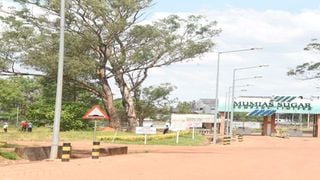
The entrance to Mumias Sugar Company.
| File | Nation Media GroupBusiness
Premium
After 40 years, forget Mumias Sugar and just sell factory as scrap metal
We must bring the Mumias Sugar factory revival lie to an end – and save the next generation from growing the wrong crop on smallholder schemes.
Mumias is the tale of folly and politicians, and now that we are in the campaign season, will continue to use it as bait; dangling the monolith to smallholder farmers with the promise of revival. The sad part is that this promise is now dud but every year it costs us, the taxpayers, billions of shillings to maintain the dead horse. In 2020, the government said it had written off Sh62 billion in debt owed by sugar factories. Mumias, the largest of them, owed the Kenya Revenue Authority (KRA) a staggering Sh11 billion.
While that was written off last year, it did not stop Kenya Commercial Bank (KCB) from demanding Sh540 million that this money pit had taken and failed to pay. It is now in receivership.
And this story is not about Mumias — the playground of cartels and Western Kenya politicos — but about the poor farmers who have been left with a cash crop that is only economically suitable for plantations.
Why the government still thinks that cane can be profitable in small shambas is our bottom-up nonsense. Kenya has done a lot of task force reports on the sugar industry, but the most important question is never addressed: How profitable is sugar cane grown in small shambas?
Big plantations
Either we grow cane the way it is grown elsewhere, or we stop these experiments that have left the sugar-belt much poorer. In Africa, big sugar plantations first emerged in South Africa when Sir Charles George Smith establishment what was to become Africa’s biggest sugar producer — Illovo Sugar Ltd — in the Natal Province. It is this plantation success that today informs the sugar industry in Zambia, Malawi, Swaziland and Tanzania, where the company has invested in mega-plantations.
Even after Chemelil, which became our first experiment on smallholder sugar production in Kenya, failed — after we seized the land from Miwani owners in 1965 — we still decided to set up Mumias, hoping for a miracle.
The only difference was that Kenya abandoned the use of sugar cooperatives, which had failed in Chemelil, and went for the formation of outgrowers’ associations as the rivalry between Cabinet ministers Jeremiah Nyagah and his Co-operative counterpart Masinde Muliro continued.
Mumias has over the years become the silent case study of relying on interested parties posing as experts and the 1960s geopolitics.
When British trading company Booker McConnell was tasked in 1971 to carry out a feasibility study on sugar production, processing and marketing in Mumias, few people knew that they were interested parties in the project. Their engineering subsidiary Fletcher and Stewart Ltd was to be awarded the contract to build the factory. The British Ministry of Overseas Development provided a £2.9 million loan, which was given to Fletcher and Stewart to design and supply the plant.
Others who were brought into the project were East African Development Bank, KCB and the Commonwealth Development Corporation.
It was Booker, more than anyone else, which concluded that the project was viable, but a row emerged after they were asked to put up a substantial equity stake to the project. They refused and demanded a management contract via Fletcher and Stewart. This management contract was given to their other subsidiary, Bookers International and Technical Services (BATS).
When they realised that they could burn their fingers on Mumias, BATS started pushing for an expansion of the project area at a time their other managed company, Chemelil, was operating below capacity for lack of cane.
There was a reason the British and the Kenyatta government financed this project. As the largest sugar scheme in East Africa, Mumias provided the best visibility. But one concern was that Mumias would not offer a good return and “did not have a very high projected rate of return” — and like modern-day Galana Kulalu, this was a political project.
Economists Gerald Holtham and Arthur Hazelwood would later write: “Some reservations were felt about Mumias within ODM (Overseas Development Ministry) because of (its) effect on East African economic co-operation. At that time, Kenya imported its sugar requirements from Uganda, which had some advantages as a sugar producer. At the price paid for Uganda sugar, the Mumias project did not have a very high projected rate,” they wrote.
There was also fear that if Britain did not fund the project, other donors would — and thus, Mumias Sugar, with all its problems, was born.
We now know that the British financed the project to keep off the Germans, Russians and Chinese, who had shown interest in financing a sugar project earlier on. At first, Germany had financed Chemelil, much to the chagrin of the UK.
Government documents show that Russian investors had demanded some 20,000 acres for a nucleus estate but since this was not available as a single block, they left. The Chinese also rejected to put their money into a project with smallholders as the drivers.
We should learn — or should have learnt by now — from Brazil, where smallholder production accounts for only 3 per cent of total sugar. With its mechanised plantations, Brazil is today a global leader in crop technology, while Mumias, and others, still rely on ‘prehistoric’ cane cutters.
Some recent studies on the cane industry in Brazil have shown that over the years, there has been a decrease in the ratio of workers per hectare and the sugar cane acreage has been increasing. More so, Brazil’s policy is to continue supporting the plantations to command the global sugar industry.
The country has also exploited the high demand for ethanol and actually, they hardly grow sugar cane to extract sugar but to feed the expanding ethanol mills.
A few years ago, I walked into the Kenya National Archives and sought to see the government files on the sugar industry. I found out that Kenya had been warned of the dangers of starting a sugar industry based on outgrowers’ cane. But officials at the Ministry of Agriculture decided to go ahead because it made political sense — and again, the Jomo Kenyatta government was under pressure from Western Kenya leaders to allow them to grow a new cash crop.
Discipline
Had the government listened to a warning, nay observation, contained in a now declassified letter dated August 5, 1971, and written by Commonwealth Development Corporation sugar consultant, BCJ Warnes, perhaps we would not be in this position.
Mr Warnes went on record saying that the sugar sector required lots of discipline — which could not be achieved in smallholder farms: “The outgrower is an individual. He can’t be hired and fired even if it were politically acceptable to do so, which it is not. And yet the collective fortunes of the entire body of outgrowers, and the milling company itself, depend absolutely on the willingness and ability of each and every grower.”
I am not sure whether this letter reached Jomo’s State House, but at least it reached the desk of the commissioner of cooperatives, Mr Joshua Muthama, and the Agriculture deputy secretary, Mr G Musembi. Did they inform their bosses? We don’t know.
After observing the sugar industry in other countries, and where it was profitable, Mr Warnes said that “High throughputs call for some very exact timing and coordination on the cane growing side … it is not sufficient to merely produce the total quantity of cane required annually. It has to be grown, harvested and delivered with almost split-second timing so that exactly the right amount of cane goes on arriving at the mill round the clock, day after day and week after week.”
This synchronisation, and which is the hallmark of the sugar industry, no longer exists; – not on the ground.
One of the first problems that faced Mumias is that by the time the feasibility studies were being done, the farmers had been engaged for the pilot project and politically, there was no way the Kenyatta government could walk away. And that could partly explain the shelving of a report by a sugar agronomist, which dismissed some parts of project area soils as unsuitable for cane.
Pilot project
The report by EM Johnson, whose firm was carrying out the pilot project, informed the government that for Mumias to be profitable, it would require its own 10,000 acres of a nucleus estate and to produce, on its own, 50 per cent of the required cane. By the time it was collapsing, the nucleus estate, now invaded by locals, was only contributing 6 per cent, or less, while the balance was sourced from either contracted outgrowers or private farmers.
Another worry by Mr Johnson was the flooding on the lower slopes of River Nzoia which was the proposed nucleus area, which he said required extensive drainage. Away from the nucleus, Mr Johnson found that the outgrower areas further from Nzoia were “interspaced with shallower soils less suited to sugar production.”
And this is partly at the heart of the problem. If Mumias expects more than 70 per cent of its cane to come from these outgrowers whose farms are on poor soils, then how productive will the farms be? This means that good quality cane, all other factors notwithstanding, would have been compromised in the outgrower areas and yet this is the area that now forms the bulk of supplies for the ailing factory.
Over the years, the proposed acreage per household has diminished and it appears like Mumias was projected to have no population growth.
As we-shall-revive-Mumias politicians hover above the voters, only the brave will dare say: Let go this scrap metal, and we’ll get you another cash crop.
[email protected] @johnkamau1





